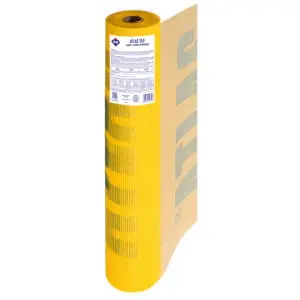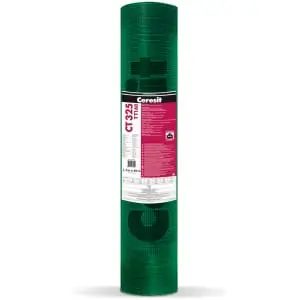Mesh
Reinforced Fibreglass Mesh for EWI — Crack Control and Impact Resistance
Reinforced fibreglass mesh is the core reinforcement layer in EWI and render-only systems. It controls surface cracking, improves impact resistance and helps the basecoat cure evenly for a stable finish. For higher loads, render mesh 160g increases stiffness without adding bulk. Additionally, combined accessories such as a corner bead with mesh and a drip profile with mesh protect edges and plinths, keeping façades clean and durable.
Why it matters
Firstly, reinforcement spreads stresses across the façade, reducing hairline cracks and corner damage. Secondly, it protects vulnerable zones such as ground floors and reveals. Finally, paired with the correct adhesive/basecoat, EWI mesh ensures consistent results across large elevations and complex details.
Grades, roll sizes and specification
Choose the right grade for your project scope. For standard façades, a 150 g/m² mesh such as Atlas Reinforcing Mesh 150g (50 m² roll) provides reliable crack control. For higher traffic or stress points, step up to render mesh 160g (CT325, 55 m² green roll). Moreover, both options are alkali-resistant to suit cement-based mortars and long-term exterior exposure.
Edges, corners and drip details
In addition to field reinforcement, use profiles that combine geometry and mesh for clean, durable edges. For straight 90° corners choose a corner bead with mesh. For curved openings specify an arched corner bead with mesh. Furthermore, protect plinth edges and shed water using a drip profile with mesh to reduce staining and premature wear.
Installation essentials
Embed the fabric wet-on-wet into a continuous basecoat, maintaining a flat plane without waves. Overlap adjacent runs as per system guidance and double-mesh stress zones (openings, corners, plinths) for additional resilience. For a practical overview of sequencing, see our step guide to applying silicone render which includes the reinforcement stage (installation sequence). Likewise, this short article explains the basics of what fibreglass mesh is and why it’s used. In short, this reinforced fibreglass mesh approach improves long-term durability.
Popular products
- Atlas Reinforcing Mesh 150g — 50 m² roll
- Ceresit CT325 Fibreglass Mesh 160g — 55 m² green roll
- PVC Corner Profile with Mesh — 2.5 m
- PVC Arched Corner Bead with Mesh — 3 m
- Drip Profile with Mesh — 2.5 m
System integration
For best performance, pair the mesh with compatible adhesives and basecoats and finish with a primed, thin-coat render. Consequently, reinforced fibreglass mesh helps the entire build‑up resist impact, thermal movement and moisture over the long term.
FAQ
150 g/m² vs 160 g/m² — which should I choose?
As a rule, 150 g/m² suits standard façades, while 160 g/m² is preferred for higher stress or traffic zones, giving extra stiffness and impact resistance.
Is the mesh alkali-resistant?
Yes. Both options are specified as alkali resistant mesh designed for cement-based mortars and exterior exposure in EWI systems.
Do I need special beads for edges and curves?
Yes. Straight corners use a corner bead with mesh, while curves require an arched corner bead with mesh for shape retention and durability.
Where should I double-mesh?
Double up at openings (lintels, jambs), façade corners and splash zones. This concentrates reinforcement where cracks are most likely to form.
Will this work with any basecoat?
Use EWI-rated mortars and primers from the same system family for guaranteed compatibility. In short, the fibreglass mesh must be embedded into a continuous, appropriate basecoa
Reinforced Fibreglass Mesh for EWI — Crack Control and Impact Resistance
Reinforced fibreglass mesh is the core reinforcement layer in EWI and render-only systems. It controls surface cracking, improves impact resistance and helps the basecoat cure evenly for a stable finish. For higher loads, render mesh 160g increases stiffness without adding bulk. Additionally, combined accessories such as a corner bead with mesh and a drip profile with mesh protect edges and plinths, keeping façades clean and durable.
Why it matters
Firstly, reinforcement spreads stresses across the façade, reducing hairline cracks and corner damage. Secondly, it protects vulnerable zones such as ground floors and reveals. Finally, paired with the correct adhesive/basecoat, EWI mesh ensures consistent results across large elevations and complex details.
Grades, roll sizes and specification
Choose the right grade for your project scope. For standard façades, a 150 g/m² mesh such as Atlas Reinforcing Mesh 150g (50 m² roll) provides reliable crack control. For higher traffic or stress points, step up to render mesh 160g (CT325, 55 m² green roll). Moreover, both options are alkali-resistant to suit cement-based mortars and long-term exterior exposure.
Edges, corners and drip details
In addition to field reinforcement, use profiles that combine geometry and mesh for clean, durable edges. For straight 90° corners choose a corner bead with mesh. For curved openings specify an arched corner bead with mesh. Furthermore, protect plinth edges and shed water using a drip profile with mesh to reduce staining and premature wear.
Installation essentials
Embed the fabric wet-on-wet into a continuous basecoat, maintaining a flat plane without waves. Overlap adjacent runs as per system guidance and double-mesh stress zones (openings, corners, plinths) for additional resilience. For a practical overview of sequencing, see our step guide to applying silicone render which includes the reinforcement stage (installation sequence). Likewise, this short article explains the basics of what fibreglass mesh is and why it’s used. In short, this reinforced fibreglass mesh approach improves long-term durability.
Popular products
- Atlas Reinforcing Mesh 150g — 50 m² roll
- Ceresit CT325 Fibreglass Mesh 160g — 55 m² green roll
- PVC Corner Profile with Mesh — 2.5 m
- PVC Arched Corner Bead with Mesh — 3 m
- Drip Profile with Mesh — 2.5 m
System integration
For best performance, pair the mesh with compatible adhesives and basecoats and finish with a primed, thin-coat render. Consequently, reinforced fibreglass mesh helps the entire build‑up resist impact, thermal movement and moisture over the long term.
FAQ
150 g/m² vs 160 g/m² — which should I choose?
As a rule, 150 g/m² suits standard façades, while 160 g/m² is preferred for higher stress or traffic zones, giving extra stiffness and impact resistance.
Is the mesh alkali-resistant?
Yes. Both options are specified as alkali resistant mesh designed for cement-based mortars and exterior exposure in EWI systems.
Do I need special beads for edges and curves?
Yes. Straight corners use a corner bead with mesh, while curves require an arched corner bead with mesh for shape retention and durability.
Where should I double-mesh?
Double up at openings (lintels, jambs), façade corners and splash zones. This concentrates reinforcement where cracks are most likely to form.
Will this work with any basecoat?
Use EWI-rated mortars and primers from the same system family for guaranteed compatibility. In short, the fibreglass mesh must be embedded into a continuous, appropriate basecoa



